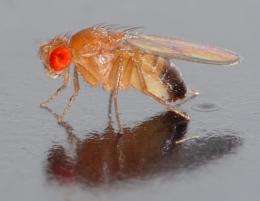December 10, 2013 report
Study unlocks secret of how fruit flies choose fruit with just the right amount of ethanol

(Phys.org) —Researchers from the University of California working with a team at Howard Hughes Medical Institute in Virginia, have discovered how it is that fruit flies are able to lay their eggs in rotting fruit that has just the right amount of ethanol in it to promote healthy young. In their paper published in Proceedings of the National Academy of Sciences, the team describes how they found clusters of neurons in the adult flies' brains that responded differently to different levels of ethanol.
Fruit fllies are notorious for showing up just as fruit begins to rot. Prior research has found they are able to smell the ethanol from a great distance and that the flies both eat the rotting fruit and use it as a repository for their eggs. In this new effort, the researchers have found that the flies are also able to determine the level of ethanol in the fruit and to move on if it's not just right for the best development of their offspring. Too little ethanol, the researchers report, results in too-heavy offspring that have difficulty flying. Too much ethanol causes a delay in development which reduces their chances of reproducing. The right amount is apparently 5%—about the same as beer.
To ascertain if the fruit is right for rearing little ones, the adult female relies on clusters of neurons in its brain, the team found, that actually work against one another. All of the neurons release dopamine, but the types of neurons differ in response to ethanol. One type causes the fly to seek it out, the other to avoid it—or at least too much of it. Thus, one group of neurons cause the mom–to-be to seek out fruit with ethanol in it, while another causes her to keep on moving if the stimulation is too strong. When the level is just right, she lays her eggs.
As a follow-up, the research team also traced the path of brain stimulation as ethanol was breathed in. They found that some regions of the brain that responded to stimulation got busy, while at the same time other regions that are believed to be involved in decision-making and memory lit up as well. This suggests that the flies were drawn in by the pleasurable aroma of ethanol, but then used logic to decide if the levels were right for baby-raising.
More information: Competing dopamine neurons drive oviposition choice for ethanol in Drosophila, PNAS, Published online before print December 9, 2013, DOI: 10.1073/pnas.1320208110
Abstract
The neural circuits that mediate behavioral choice evaluate and integrate information from the environment with internal demands and then initiate a behavioral response. Even circuits that support simple decisions remain poorly understood. In Drosophila melanogaster, oviposition on a substrate containing ethanol enhances fitness; however, little is known about the neural mechanisms mediating this important choice behavior. Here, we characterize the neural modulation of this simple choice and show that distinct subsets of dopaminergic neurons compete to either enhance or inhibit egg-laying preference for ethanol-containing food. Moreover, activity in α′β′ neurons of the mushroom body and a subset of ellipsoid body ring neurons (R2) is required for this choice. We propose a model where competing dopaminergic systems modulate oviposition preference to adjust to changes in natural oviposition substrates.
Journal information: Proceedings of the National Academy of Sciences
© 2013 Phys.org



















